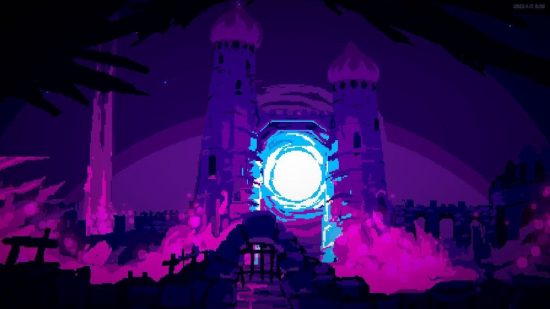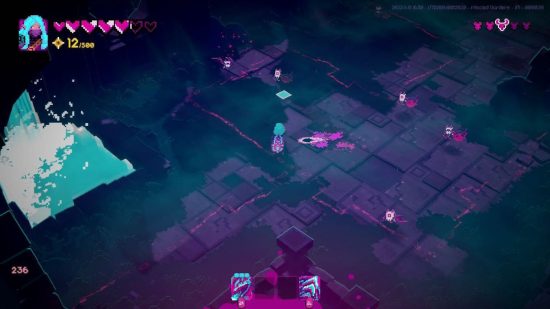Our Verdict
Lone Ruin is a roguelike with style but it lacks in originality, making for an overall experience that's worthwhile for fans of Hades and Diablo, but one that doesn’t quite match up to the epic scale of those adventures. Still, anyone with a love for dungeon crawling and fast-paced combat will have a blast here, and for the price, the replayability is a real boon.
As the first 2023 offering from Super Rare Games, I was incredibly excited to pick up Lone Ruin. After already enjoying Grapple Dog and Post Void last year, we at Pocket Tactics have been anticipating each new release from the exciting indie publisher, and when offered this roguelike developed by Cuddle Monster Games to start off the new year, I couldn’t say no. And I’m glad I didn’t, as while Lone Ruin might not set the world on fire, even if it is equipped with fireballs, it is some good honest gaming fun.
From the outset, you can tell that Lone Ruin is all about replayability, with a simple UI that lends itself to the roguelike die-and-die-again gameplay loop with a lack of complications. There are three different difficulties, easy, medium, and hard, with a discernable difference between each when it comes to gameplay, as well as the option to change your button mapping, but outside of that, there aren’t endless menus or choices to be made before you start playing, you’re just thrown into the dungeon, given a spell (your weapon), and left to cause some havoc.
The gameplay loop I mentioned is pretty simple, you begin every run at the opening to the magical ruins, before you’re gifted a spell by the mysterious being at the entrance, and left to battle your way through. Each level has waves of enemies that you have to take out to earn a power-up, or an upgrade to a spell you already know, with a split path option for every next dungeon to give you some options with your build. If you’re thinking “that sounds pretty similar to Hades”, then you would be correct, it’s essentially the same gameplay loop, including a boss battle every few levels. We’ll get into those similarities later.
The story of Lone Ruin is pretty loose, though admittedly this serves the gameplay, as you strive to push further into the game and find out more about the mysterious and magical explorer you play as. There’s just a short clip before each run, detailing your approach to the ruins in question, before you’re right in at the deep end. Still, like this game’s most obvious influence Hades, sometimes the deep end is the best place to be because you have to adjust, and with a few runs, you’ll know the score all too well.

Visually, Lone Ruin is somewhere between Diablo and Tron, with the dilapidated dungeons you battle through full of neon blues and greens that fizz around the screen. The environment design is a highlight, with the ruins you’re left to wander varied in layout and with plenty of charm, though in my opinion, the monsters you battle are a little lacklustre in the looks department, and can sometimes appear a little cartoonish compared to the visuals of the rest of the game.
The secondary game mode, survival, gives you the chance to test your combat abilities by facing endless waves of baddies and bosses. It’s an obvious option to include for the developer, adding even more replayability to the oodles that already exist, but I find it useful to check out the survival mode after hitting a bit of a wall with my combat skills in the main game, and on returning to proper runs, it feels like I’ve just done a little time in the Lone Ruin gym, and I feel all the better for it.
In terms of combat, you can feel Lone Ruins’ influences in every swing of your scythe or barrage of ballista shots, or whatever spell option you choose, there are eight to choose from. Again, it’s very, very similar to Hades, which in turn is pretty similar to Doom, and, at least in my opinion, certain sections and bosses infuse a sort of Nier-vibe onto the game, with the dungeon-crawling sidestepping seamlessly into bullet-hell gameplay. It’s not quite as fluid as its influences, with the occasional slightly misleading hitbox leading me to have little mid-run tilts, and the dash feeling a little jittery at points, but if you love Supergiants’ underworld exploration or Activision Blizzard’s demon slayer, you’ll probably love this too.
My one criticism of Lone Ruin is that, as you can probably tell by now, it feels a little too similar to Hades in some places. I completely understand that great games will always see imitations – and those imitations can be great too, just take Stardew Valley’s twist on Harvest Moon for proof of that – but at points, Lone Ruin holds its own without heavily lending from Hades’ core mechanics, and I’d like to see a bit more originality in gameplay.
Performance on Switch is great, with no stutter, lag, or anything that remotely impacted gameplay. Sure, that’s to be expected from an indie that’s what I would earnestly call “lo-fi”, but thanks to Sports Story and Pokémon Scarlet & Violet, I’ve played a lot of buggy games recently, and it’s nice to tinker with something that’s as smooth as fresh butter.
All-in-all, while Lone Ruin might struggle in terms of originality, it’s offering a lot of people something that they want, more high-intensity rogue-like dungeon duels with a pacey protagonist, with plenty of challenging bosses, variations of minions to take out, and enough build options to get really creative with runs. You can’t really moan at that.


